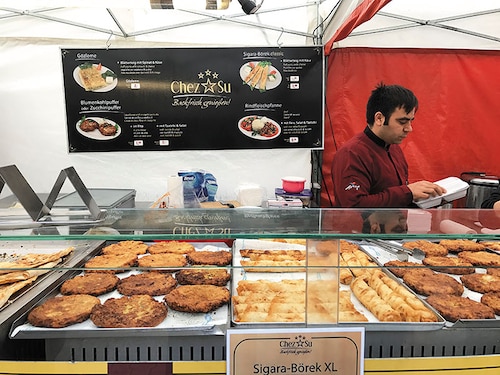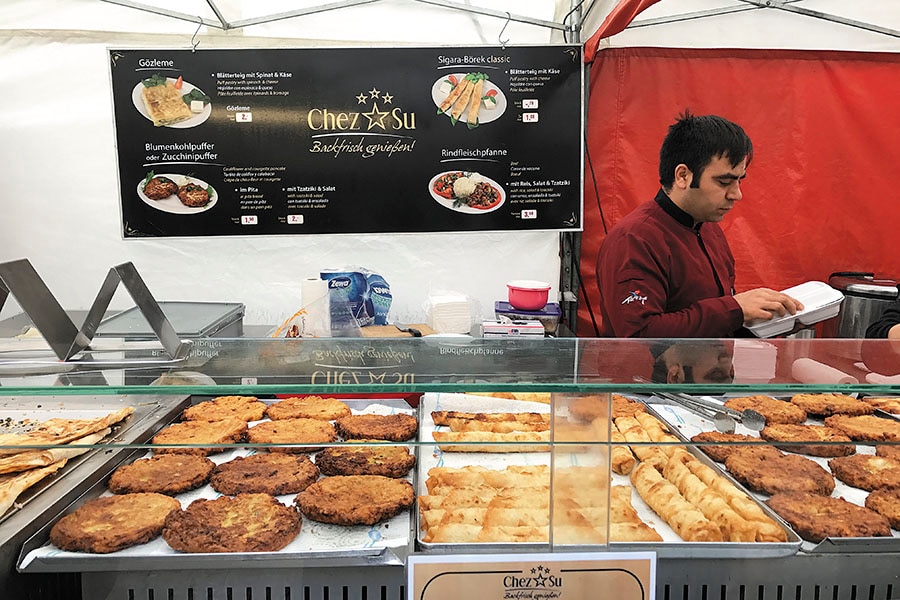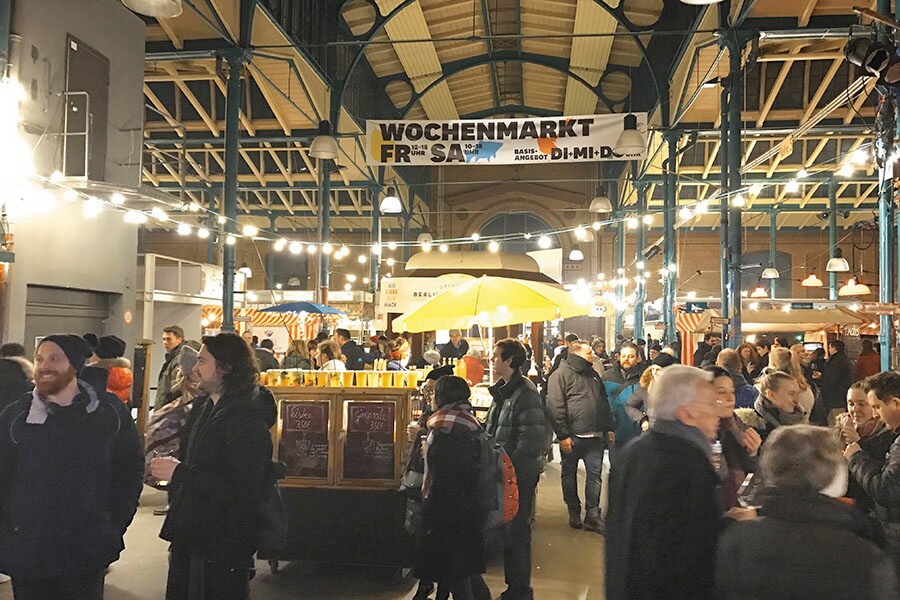In Berlin, a taste of the world
Cultures and flavours co-mingle in the various street-food markets that thrive in the cosmopolitan city


 Chez Su at the Turkish Market in Kreuzberg offers lovely food don’t miss the cauliflower and zucchini cutlets, or the cheese-filled Turkish rolls
Chez Su at the Turkish Market in Kreuzberg offers lovely food don’t miss the cauliflower and zucchini cutlets, or the cheese-filled Turkish rolls
Image: Vaishali Dinakaran
I’m sitting at a table sipping piping hot masala chai, trying to moderate a friendly argument between two gentlemen from Berlin and a young lady from Kazakhstan. I nearly choke on my chai, partly because it’s hot, partly because I fear the discussion is heading in a dangerous direction. At that precise moment, we’re interrupted by someone who has an interesting, if strange, proposition. He tells us that his name is Mario. That he’s from Colombia. And that for the price of one euro, he will recite a poem to us. It seems like a very good idea.
“Among possible maybes of green winter leaves, A poet’s ideal lays far beyond trees…” Mario begins.
He needs to shout the words a little, because the high-domed Markthalle Neun (which translates to ‘Market Hall Nine’), on Berlin’s Eisenbahnstrasse in Kreuzberg, is chock-full of people. Every week, Markthalle Neun hosts Street Food Thursday, between 6 pm and 9 pm, easily Berlin’s most popular street-food market. Housed within the original Markthalle IX building that first opened to the public in 1891, the new version of the market flung its doors open in 2011 and brought people flocking right back.
It’s easy to see why. Before I get to Street Food Thursday, let me explain the wonders of Markthalle Neun by itself. Between Tuesday and Thursday, from 11 am to 6 pm, locals troop in to buy everything from fresh produce, organically grown vegetables, fresh meat and seafood, to rather more exotic whole spices, spice blends, tofu and a range of tea and coffee. A slightly amplified version of this is seen on weekends, with more vendors and more wares on offer on Fridays and Saturdays. But it’s Street Food Thursdays that give the hungry Berliner or famished tourist the gastronomic experience of a lifetime. (Clockwise from left) A pan full of Turkish kofte a cheese-filled empanada and Indonesian serabi pancake at Street Food auf Achse
(Clockwise from left) A pan full of Turkish kofte a cheese-filled empanada and Indonesian serabi pancake at Street Food auf Achse
In addition to the existing cafes and bakeries, the entire space is transformed with a multitude of stalls, each serving up delicacies from a different part of the world. Whether you’d like to try cheese and spinach-filled empanadas from Uruguay Portuguese custard tarts — those heavenly little bite-sized desserts invented in the Belem region of Lisbon gol guppes with the power to refresh the homesick soul from the subcontinent or some steaming hot Taiwanese rice bowls with either pork belly or mushrooms lending it flavour, there really is something for everybody. In the name of research, I ate my way through all of the dishes that have been listed out, ably assisted by two fork-wielding friends, and we liked it all. So much so that we went back the following week, simply because the draw of the happy market hall, full of laughter, chatter, and cheerful people eating good food, proved to be impossible to resist. And there was more food to try. Especially the rolls at Chaiwallahs.
Chaiwallahs is a Berlin street-food style restaurant that also puts up a stall in Markthalle Neun once a week. The stall is almost always crowded, and the food is often sold out fast. They usually serve their very popular naanwiches, or what we’d call rolls in India. The naan is handmade from scratch, as is the highly flavourful filling, in this case the options were paneer or pork belly. As someone who normally turns up her nose at the prospect of eating Indian food abroad, I salivated shamelessly, and though I was full, I wanted more of those paneer and pork belly rolls. They were massive, filling, and packed with authentic Indian flavour.
But food and flavours aside, I realised what made Markthalle Neun magical when I was sitting at that communal table, listening to Mario recite a poem about a girl he met and fell in love with years ago in Italy: It was its ability to attract people from all parts of the world, and make them interact with each other. For everyone you meet at the Markthalle is amiable. The chefs will tell you about the food that they make, the sommeliers will tell you about the many fine wines they have on sale, the fromagers will be happy to chat for ages about rennet and the finer-points of washed rind cheese. As for the people who catch you staring hungrily at their food? Well, they will happily point out exactly which stall they bought it from. It’s the ideal place for an evening out with family and friends. And the fact that it’s indoors, makes it an excellent choice during the cold winter months.  Lights and life at Street Food Thursday at Markthalle Neun, easily Berlin’s most popular street-food market
Lights and life at Street Food Thursday at Markthalle Neun, easily Berlin’s most popular street-food market
It was my discovery of Markthalle Neun, then, that led to my quest for the very best street-food markets in Berlin. Which is how I stumbled upon Street Food auf Achse in the Kulturbrauerei in Berlin’s Prenzlauer Berg. The Kulturbrauerei, which translates into ‘Culture Brewery’, started out as a brewery years ago. Today, much like Mumbai’s many mills, it’s become a cultural hub. It houses theatres, restaurants, and more than one bespoke designer store. But every Sunday between the 15th of January and the 12th of November, little stalls pop up in between the red brick buildings, and food is served. Since the market is outdoors, it helps to have a jacket with you, unless, of course, the forecast for the day is more than pleasant. Unfortunately for me, I chose a particularly nippy Sunday for my visit, which meant that in addition to the services of my jacket, I needed some hot apple cider to help warm me up, as I worked my way through some serabi or surabi, which are Indonesian claypot pancakes, empanadas, spicy Korean chicken wings, and Vietnamese banh gio (rice dumplings with a pork filling steamed in a banana leaf). Once again, I found myself at a communal table, this time sharing both food and conversation with strangers. The market, I was told by some affable people, is far more enjoyable in the summer. The winter bonfires are no longer needed, and jackets and thermals are replaced with shorts and flip-flops, and there’s the air of a festival to the proceedings. But irrespective of what time of the year you happen to visit Street Food auf Achse (which literally means Street Food on the Axis) make sure to notice the quaint retro food trucks that are parked all through the brauerei. It’s like stepping back into the ’70s.But as I was to discover, there was another Berlin street-food market that made me feel like I’d walked through a time portal. Tucked away in Wilmersdorf, Preussen Park is a place where Thai families in Berlin would meet over the weekend to have big old family cookouts. Eventually, these cookouts became so big and so popular, that they started attracting the attention of passers-by, who wanted to sample some of the food too. So, what had begun as a place for the Thai community to meet, cook, eat and make merry, eventually turned into Thaipark. Open between Fridays and Sundays when the weather is good (the market doesn’t open during the winter or when it’s raining) the park sees several Thai people, usually women, spread out picnic blankets on the grass, place tiny little tables with portable gas stoves on them, and cook food right there in the park.
Thaipark can be tricky though. When I first visited the park, I quite simply didn’t know where to go, because I was worried that in some cases I really might be interrupting a family picnic. But eventually, after scoping out the many vendors, and having been assured that they were indeed selling food, I opted for some dumplings that were quickly pan-fried in front of me, and worked my way through some noodles and rice. I realised, later, that I’d made some fundamental mistakes. The first was that though the timings are meant to be between noon and 10 pm, all the really good food gets sold out early. So, if you can’t make it there for lunch, it’s wiser to just skip it. The second was that, drawn by the smells that wafted my way, I had stopped and eaten some pad thai, which proved to be very average and left me disappointed. A lot of research revealed that there were specific spots that one must not miss, but are hard to find simply because the vendors don’t put up signboards or names. But go early, preferably on a summer day, and head for the stalls with the most people thronging around, clamouring for more dumplings or pork noodle soup or banana fritters and you can’t go wrong. And armed with this knowledge the next time around, I got to eat some fantastic noodle soup, terrific papaya salad, and indulge in some lovely Thai sticky rice and mango. I also managed to procure a jar of homemade sambal, which added flavour to several batches of fried rice and red curry that I whipped up in my own kitchen.  (From left) Vietnamese bahn gio at the Kulturbrauerei Korean chicken wings and Gol guppe at Markthalle NeunPerhaps the best street-food market in Berlin on a cold day though, as I was to discover, was the Türkischer Markt that runs alongside the Landwehr Kanal in Berlin’s Neukölln area. To begin with, this one isn’t strictly a street-food market. It is, quite simply, a Turkish market, where you get everything from lengths of fabric, buttons, posters and paintings, jewellery, and the odd knick-knack and curio, to spices, lentils and a variety of fresh vegetables. Which is why you’ll find plenty of Kreuzberg and Neukölln dwellers coming here every Tuesday and Friday between 11 am and 6 pm, which is when the market is open, to do their weekly shopping. But, there certainly is food, and it’s certainly worth visiting the market for. Whether you’re in the mood for some hot Turkish coffee, which I needed given that my two jackets were failing me miserably, hot toasted nuts of various kinds, or some tea brewed traditionally in çaydanlıks (Turkish two-stacked kettles) and served in transparent glasses, there’s a stall for everything. Don’t miss the cauliflower cutlets served in thin dürüm, or the Turkish köfte that taste a lot like the Indian seekh kebab. Or the opportunity to bargain and haggle—it’s one of the few places where you can actually try your hand at it in Berlin.
(From left) Vietnamese bahn gio at the Kulturbrauerei Korean chicken wings and Gol guppe at Markthalle NeunPerhaps the best street-food market in Berlin on a cold day though, as I was to discover, was the Türkischer Markt that runs alongside the Landwehr Kanal in Berlin’s Neukölln area. To begin with, this one isn’t strictly a street-food market. It is, quite simply, a Turkish market, where you get everything from lengths of fabric, buttons, posters and paintings, jewellery, and the odd knick-knack and curio, to spices, lentils and a variety of fresh vegetables. Which is why you’ll find plenty of Kreuzberg and Neukölln dwellers coming here every Tuesday and Friday between 11 am and 6 pm, which is when the market is open, to do their weekly shopping. But, there certainly is food, and it’s certainly worth visiting the market for. Whether you’re in the mood for some hot Turkish coffee, which I needed given that my two jackets were failing me miserably, hot toasted nuts of various kinds, or some tea brewed traditionally in çaydanlıks (Turkish two-stacked kettles) and served in transparent glasses, there’s a stall for everything. Don’t miss the cauliflower cutlets served in thin dürüm, or the Turkish köfte that taste a lot like the Indian seekh kebab. Or the opportunity to bargain and haggle—it’s one of the few places where you can actually try your hand at it in Berlin.
And so, I found myself clutching a bag of assorted toasted nuts, walking through the Turkish Market, taking in the sights, but also absentmindedly planning a visit to the Bite Club (another one of Berlin’s must-visit street food markets that was then still a few weeks away from opening for the season) and wondering what it is about the combination of Berlin and street food. I watched as a young German man bought some Turkish lamb skewers and began polishing them off with relish, and then it occurred to me.
Berlin is a city that is as welcoming of various cultures as it is possible for a city to be. Which is why, perhaps, alongside the humble German würstbrötchen (or sausage in bread) and currywürst (sausages in tomato sauce with curry powder), the döner kebab, falafel, sushi, crepes, and a veritable cornucopia of other dishes from various corners of the world thrive. Not just in stores and restaurants, but at the many spring, summer, winter and flea markets that the city is dotted with at various points in the year. And thus cultures mingle, palates are acclimatised to foreign tastes, and ideas are exchanged. The word that I’m looking for, perhaps, is cosmopolitan.
First Published: Jun 25, 2017, 07:26
Subscribe Now